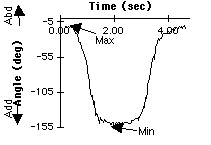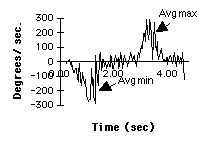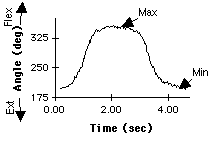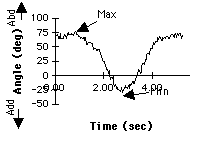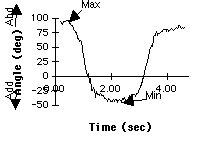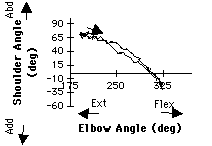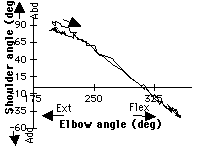RESULTS: Angular Kinematics
Segment angle. The segment (absolute) angle we analyzed was the left upper arm segment between the left wrist and left shoulder. The maximum angle and minimum angle and range of motion for the wide gripped pull-up were -16 degrees, -85 degrees, and 69 degrees respectively. In comparison, the narrow gripped pull-up elicited a maximum angle of -6 degrees and a minimum angle of -146 degrees. Range of motion equaled 140 degrees.
|
|
|
|
Figure 3. Upper arm segment angle during the wide pull-up (left) and the narrow pull-up (right). Segment angle was calculated by placing a coordinate system at the distal end of the segment, in this analysis the elbow, and measured counterclockwise from the vertical coordinate system. Anatomical position of the upper arm corresponds to -180 degrees. Zero degrees represents full abduction while angles less than -180 indicate adduction. Positive values represent clockwise rotations. | |
Segment velocity. The segment velocity of the left elbow segment in the wide gripped pull-up showed an average maximum angular velocity of 110 degrees/s during the extension phase near the end of the movement ("going down"). The average minimum angular velocity occurred while moving into flexion position at -100 degrees/s. In contrast, the average maximum angular velocity during the narrow gripped pull-up occurred at 152 degrees/s and the minimum angular velocity was -187 degrees/s. At the midpoint of the movements where the flexed elbow position was held, the angular velocity equaled zero.
|
|
|
|
Figure 4. Upper arm segment angular velocity in the wide pull-up (left) and the narrow pull-up (right). Positive velocity values represent clockwise rotations. | |
Joint angle1. We analyzed the left elbow for our first joint angle. During the wide gripped pull-up, the maximum (flexion) and minimum (extension) angles and range of motion of the left elbow were 325 degrees, 190 degrees, and 135 degrees, respectively. However, during the narrow gripped pull-up, the maximum angle (flexion) was 349 degrees and the minimum angle (extension) was 191 degrees, resulting in a 158 degree range of motion.
|
|
|
|
Figure 5. Elbow joint angle in the wide pull-up (left) and the narrow pull-up (right). The elbow angle was calculated between the forearm segment and the upper arm segment in the counterclockwise direction. Anatomical position of the elbow corresponds to 180 degrees. Angles greater than 180 degrees indicate flexion while angles less than 180 degrees represent extension. | |
Joint angle 2. The second joint angle we analyzed was the left shoulder. During the wide gripped pull-up the maximum joint angle (abduction) achieved was 75.0 degrees and the minimum angle (adduction) was -30.0 degrees. This resulted in a 105.0 degree range of motion. In contrast, the maximum joint angle (abduction) during the narrow gripped pull-up was 103 degrees, while the minimum angle (adduction) produced was -37 degrees. The range of motion for the narrow gripped pull-up equaled 140 degrees.
|
|
|
|
Figure 6. Shoulder angle in the wide pull-up (left) and the narrow pull-up (right). Shoulder angle was calculated between the upper arm segment and the shoulder-to-c7 segment in the counterclockwise direction. Anatomical position of the shoulder corresponds to 0 degrees. Angles greater than 0 degrees represent abduction while angles less than 0 degrees indicate adduction. | |
Angle-Angle Plot. When the shoulder joint was analyzed against the elbow joint, we discovered a tightly coupled relationship between the two joints. Our analysis showed that these joints move together. First, during the "up" phase of the pull-up, the shoulder adducts while the elbow flexes. Then, the shoulder abducts while the elbow extends during the "down" phase.
|
|
|
|
Figure 7. Coordination of shoulder and elbow joint angles in the wide pull-up (left) and the narrow pull-up (right). The arrow shows the direction of movement; the tail of the arrow indicates the first frame of the movement. | |

